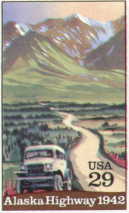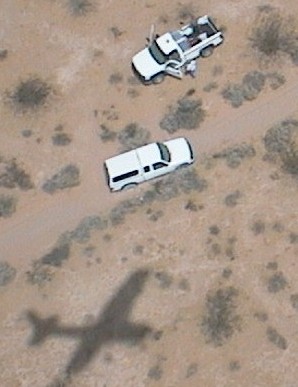
Home
Aviation Stories
"In Memory Of"
Net Sites
Sign Guestbook
View Guestbook
Email Ron
Sell your Trust Deed

SAR Finds Lost Bouse ResidentsReprinted from the September 24, 2003, issue of the Parker Pioneer newspaper, Parker, Arizona.
Story and Photos
By Ron KilberSALOME, AZ, Tuesday, September 9, 2003.
When my phone rings at 9:30 a.m., I learn that La Paz County Search and Rescue (SAR) needs a pilot and plane to search for two people who've been stranded in the desert overnight somewhere southwest of Bouse. I accept the mission, agreeing to report overhead the SAR Command Post (CP), which has already been set up along Plomosa Road at mile-marker 16.9 south of Bouse.

Victim's pickup in wash with sand up to the axles (bottom).At 10:30 a.m., while a rain storm quickly approaches from the east and a strong crosswind blows from the south, I begin my Cessna take-off roll westerly on Runway 26 from Indian Hills Airpark just south of Salome. It has taken about an hour to prepare for this mission. Fueling, pre-flighting, checking the weather, and coordinating with other members all take time. SAR member Linda Jones has agreed to join me to help spot the victims from the air. As we climb out, the wind forces me to point the nose towards Quartzsite, even though we're tracking a course directly to Bouse. Looking behind, we see the storm overtaking the airfield in back of us. I would've aborted my plans to fly had our take-off been delayed a few more minutes.
Twenty minutes later, we're circling the CP just south of Bouse. The Incident Commander is Sergeant Karen Harris, La Paz County Sheriff's Office. She informs us via radio that a white Ford Ranger with a camper top is stranded somewhere between the Plomosa Mountains and Plomosa Road. Two Bouse adults have been missing since early yesterday.
After thirty minutes of flying a grid pattern over the entire area in question, Jones and I land on Plomosa Road after coming up empty-handed. If there had been a white pickup below us, we would've seen it. As it was, we only saw SAR ground vehicles combing the area.
When we talk to Sgt. Harris on the ground, it turns out that SAR has been looking in the wrong area. We now learn that a third victim, Richard Artherton, 63, Bouse, hiked out last night from La Posa Plain, which is on the western side of the Plomosa Mountains. We had been searching the eastern side.
Artherton tells us that he, his wife Delores Artherton, 64, and friend Walter Buyers, 58, broke down in a wash about noon yesterday. They were on their way to eat hamburgers in Quartzsite via a back way that was suppose to offer opportunity to see sheep watersheds. Artherton's front-wheel drive gave out in the soft sand. After that, the wheels sunk to the axles.
Artherton began his hike at 3 p.m. yesterday, making his way six or seven miles in summer heat to Plomosa Road, arriving about 7:00 p.m. in moonlight. There he bumped into a pickup and good Samaritan who had been viewing the clear, night sky.
Atherton accepted a ride into Bouse, commenting, "My legs were so tired that I had to use an arm to lift a leg into that high pickup."
Once home in Bouse, Atherton contacted Buyers' girlfriend Wanda Tucker, 57, of Bouse. Together they made an effort to rescue the stranded wife and friend. But darkness overwhelmed their efforts. Fate had both victims spend the night together in the desert with very limited food and water. Finally, SAR was contacted early this morning.
Within minutes, Jones and I are back in the air, bee-lining for the area Atherton described. La Posa Plain is huge. Our field of vision affords the opportunity to see several hundred square miles at once. If we are going to spot one pickup, it'll mean we'll have to fly near it or get lucky.
As fate would have it, Jones points to a refection four miles west. It's a long shot, but as we fly closer and closer, we begin to see a pickup come into view. Someone is waving a white flag. We're both sure these are the victims.
It's 11:56 a.m. when Jones reports to the CP that our victims are three miles due east from Route 95. We're asked to circle until ground vehicles spot us to find their way.
At 12:19 p.m., a ground vehicle arrives to greet the victims.
Our air mission is complete. Sgt. Harris clears our return to the airpark, commenting, "I'm glad the victims stayed with their vehicles. It makes life a whole lot easier to find everyone in one place, not two or three."
Jones and I return to the airpark where the rain storm has already passed, however, the crosswind blows as strong as ever. We land safely using Runway 26 again.
All three victims are very fortunate. Had Atherton collapsed while hiking the summer heat, disaster could've been certain not only for him but his wife and friend as well. It's always best -- even though the odds are that we won't have the need -- to provision for the worst by taking extra water, food, a cell phone and -- most importantly -- letting someone know where we are going and when we are expected to return, every time we enter the desert or mountains.
Afterwards on the phone, victims, family and friends are relieved and grateful to have reunited with each other -- safely.
Artherton comments, "I wish I knew who gave me a ride so I could thank him."
He laments, "The only mistake we made was not letting someone know where we was going."
Copyright 2003 Ron Kilber All rights reserved
###
Copyright (C) 2003 Ron Kilber rpknet@aztecfreenet.org RonKilber.tripod.com